SUPERCHARGE YOUR ONLINE VISIBILITY! CONTACT US AND LET’S ACHIEVE EXCELLENCE TOGETHER!
As digital and physical realms converge in ways once relegated to science-fiction, the act of search is undergoing a profound transformation. The company THATWARE stands at the vanguard of this evolution, reimagining search not as a passive query-response act, but as a creative engine — optimising realities, simulations and even our dreams. In this new era what we once called “search” becomes “world-making”.
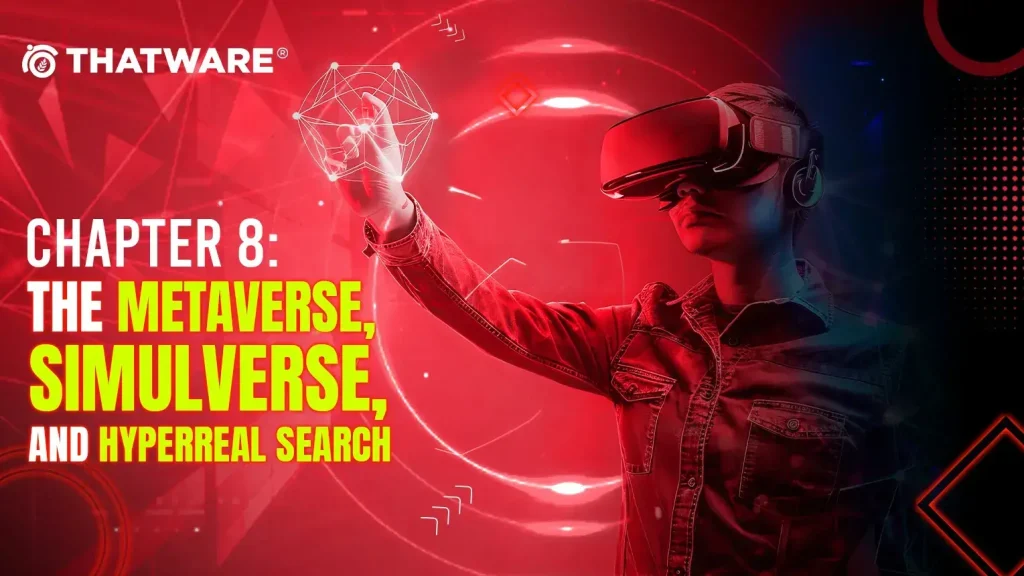
In the familiar internet paradigm, you typed keywords, scanned results, clicked links. But now imagine a search that spins into being a new realm, a simulation you inhabit, interact with, and reshape. THATWARE’s metaversal search platform doesn’t just retrieve knowledge; it incrementally generates worlds where avatars converse, virtual landscapes respond, and futures are simulated in real-time. AI, advanced spatial computing, persistent virtual environments: together they blur the old boundaries between query and creation.
We are entering an age where hyperreal worlds — blends of the actual and the constructed — are no longer niche curiosities but socio-economic substrates. The global metaverse market alone is estimated at over USD 105 billion in 2024, with a projected growth to nearly USD 937 billion by 2030. And artificial intelligence is the animating force: one peer-reviewed study describes AI as “an essential driving element behind the Metaverse’s evolution and expansion”.
For THATWARE, search is no longer a tool of retrieval — it is the mechanism of creation. When you issue a query, you initiate a universe: a simulverse built on algorithmic scaffolding, populated by intelligent agents, data visualisations, spatial experiences, and immersive narratives. These worlds are not mere apps; they are persistent — evolving after you log off, interacting with other users, adapting to new inputs. Within this landscape, AI defines worlds, choices and consequences materialise, and meaning is created rather than found.
Let’s look at some of the basic concepts:
Digital Twin SEO
In the evolving narrative of chapter 8—“The Metaverse, Simulverse, and Hyperreal Search”—we introduce a new concept: Digital Twin SEO. In this sub-domain, search ceases to be purely descriptive; search becomes generative. Your query invokes a virtual replica, a “digital twin” of a brand, product, environment or even a person—and optimization of that twin becomes the next frontier of search-strategy.
What is Digital Twin SEO?
- It means creating and optimising a virtual counterpart—an immersive, searchable and interactive digital twin—for your physical or conceptual asset.
- This twin is indexed, rendered and surfaced in metaversal search environments (where queries spawn worlds). Rather than “find my product” it becomes “enter my product-world”.
- The essence of SEO shifts: meta-tags, keywords and links now coexist with 3D models, AI agents and spatial experiences. As one analysis puts it: “real estate portals link the VR property tour with meta-descriptions and SEO video optimization” in digital twin contexts.
- As the market for digital twins balloons—from an estimated ~US $25 billion in 2024 to as much as ~US $155 billion by 2030 at ~34 % CAGR—brands that optimise their digital proxies gain first-mover advantage.
Hypothetical scenario
Imagine the brand “EdgeCycle” manufactures high-end electric bicycles. In a Digital Twin SEO paradigm:
- EdgeCycle deploys a virtual twin of its flagship bike—3D model + interactive features + voice-agent guide.
- A user searches “EdgeCycle performance test” and instead of static results they’re plunged into the twin: they ride virtually, change components, ask the AI guide questions.
- The twin is designed with its own “search optimization”: the virtual world loads quickly, the agent speaks brand keywords naturally (e.g., “EdgeCycle torque 85 Nm”), the scene links back to purchase pages.
- Analytics show X = 100 unique session entries into the twin world, with average dwell-time T = 4 minutes. If average conversion from standard web click is 2 %, but from twin-world entry is 5 %, then relative lift = (5 − 2)/2 = 150 % uplift.
- Over a month: 1,000 twin entries → 50 conversions; previously 1,000 clicks → 20 conversions. Thus twin-SEO achieved +30 extra conversions.
Why this matters
- In hyper-real search spaces, the “first page of search” may mean “first immersive world of search”. If your digital twin isn’t optimized, you don’t just lose clicks—you lose immersive presence.
- The global digital twin market growth reflects that virtual proxies are becoming mainstream infrastructure.
- Untapped advantages: greater dwell-time, richer interaction metrics, potential for brand storytelling in 3D, semantic voice queries, AR/VR indexing.
- Bullet summary of tactical shift:
– Keyword strategy → Context‐modeling (3D, VR, AI agent)
– Back-links → Spatial links and twin-world graph connectivity
– On-page content → Interactive twin experience
– Analytics → Engagement in immersive layers, not just clicks
In this chapter’s investigation of metaversal search, Digital Twin SEO stands out as a bridge: between query and world, between retrieval and creation. The question you must ask: when a user searches for you, will they find your website only, or will they enter your twin-world, shaped by your optimisation? Because if they enter a rival’s immersive universe first, your search efforts may feel flat… even obsolete.

Simulated Universe Optimisation
In the age when the boundaries between the real and the virtual dissolve, “simulated universe optimisation” becomes more than a technical ambition — it becomes the canvas on which entire realities are shaped. Imagine this: you issue a search query — “design a sustainable city-ecosystem in the year 2050” — and instead of a list of links, you step into a working simulverse built by THATWARE. In this virtual world you walk the streets of that city, tweak its energy grid, test traffic flows, change materials, and instantly see outcomes. What started as a simple search has become the creation, manipulation and optimisation of a living, evolving universe.
At its core, simulated universe optimisation follows three converging threads:
- Generation → Iteration: Each query becomes a seed world, which AI rapidly builds, then continuously refines based on user input and emergent behaviours.
- Simulation → Adaptation: Physical laws, human dynamics, economic flows are encoded into the world; new data streams feed back into the simulation, which adapts in real time.
- Optimisation → Reality Design: The goal is no longer just to find an answer but to optimise for outcomes — be it social equity, environmental resilience or profitability.
Key pillars for THATWARE’s architecture include:
• AI-driven scene generation engines that can render dynamic environments at scale;
• Real-world digital twin data streams that feed simulation parameters;
• Persistent virtual environments that evolve even when the user is offline;
• Feedback loops where user actions become data for next-generation optimisations.
Let’s walk through a hypothetical scenario: A city-planner uses THATWARE’s platform. They input: “Reduce average commute-time by 20% in the simulated year 2050.” The system spawns a city simulation of 5 million virtual citizens, 200 km of road network and multiple transport modalities. The AI assigns each citizen a schedule, origin, destination distribution, vehicle choices, even behavioural quirks. The initial average commute time computes to 45 minutes. Then the user deploys interventions: rapid transit line, micro-mobility zones, remote-work surge. The simulation re-runs and reports: average commute drops to 36 minutes — a 20% reduction. Calculation: 45 min × 0.80 = 36 min. Now the user tweaks further: increase micro-mobility adoption from 10% to 25%. The engine recomputes behaviour and perhaps finds commute time falls to 30 minutes — a 33% improvement. This iterative loop of search-spawn-optimise becomes the modus operandi.
Why now? The global market for the metaverse ecosystem is already surging: from roughly USD 105.4 billion in 2024 to an estimated USD 936.57 billion by 2030. And research underscores that AI is the catalyst behind this evolution — in one study, AI’s role was characterised as “an essential driving element behind the Metaverse’s evolution”. With these twin forces — immersive universes and intelligent agents — the act of optimisation becomes world-building.
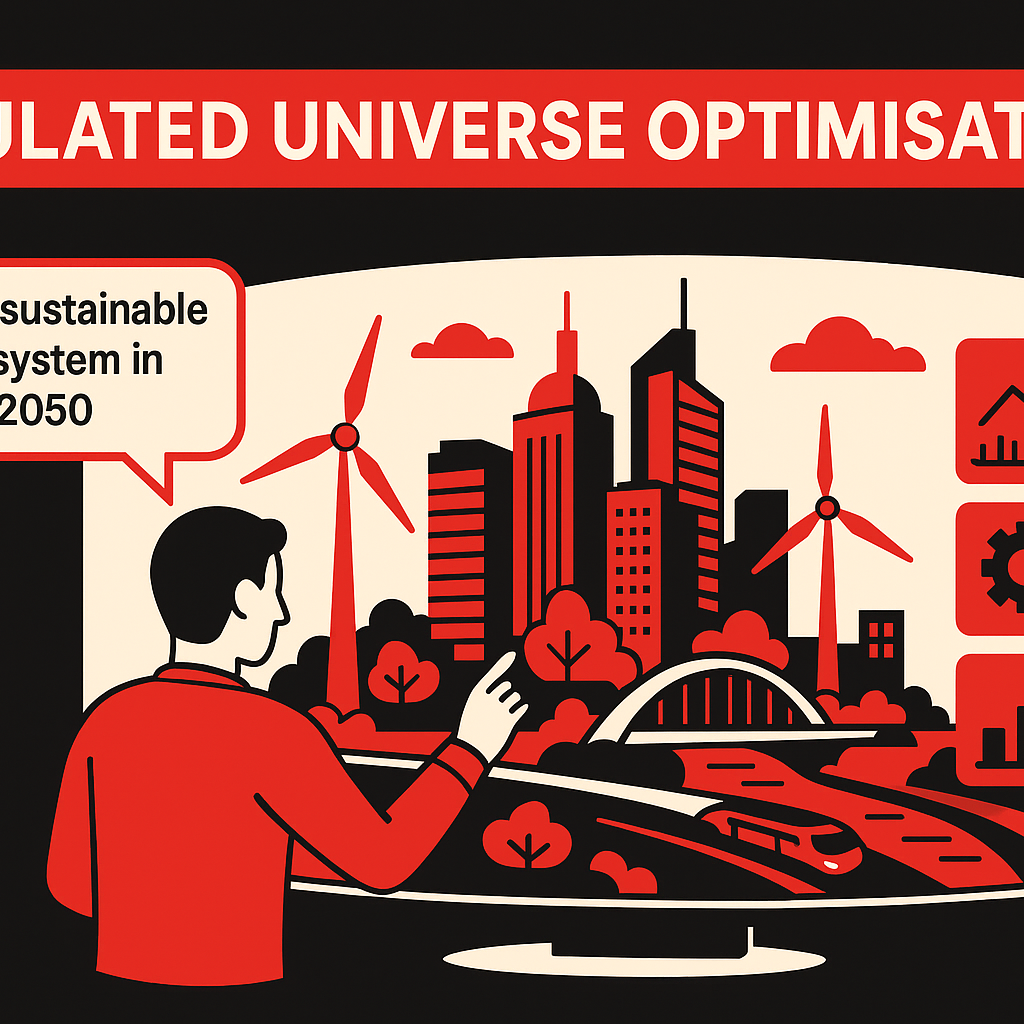
Holoverse Optimisation
In the dawning era of the holoverse, imagine a world where every search query doesn’t just retrieve information—it fabricates the space in which you stand. This is the heart of Holoverse Optimisation: the art and science of calibrating interactive, holographic universes so that they respond, evolve and resonate with users as seamlessly as physical reality. At the intersection of the virtual and the tangible, the query becomes the constructor, the algorithm the architect, and the user the inhabitant and co-creator of synthetic worlds.
Consider a hypothetical situation: A user types “show me Paris in the year 2125”. Instead of a list of web pages, the system unfolds a fully realised holographic cityscape—hovering monorails, climate-adapted Eiffel Tower, flowering sky-gardens over the Seine—all rendered in immersive holographic projection around the user. As they walk, the environment shifts: daylight to dusk, air-density changes with an interactive sensor network, voices of future Parisians drift by. The search has become a simulverse, optimised in real-time for spatial coherence, narrative immersion and sensory believability.
Key optimisation dimensions include:
- Spatial realism: calibrating light, shadow, scale and sound so the holographic realm aligns with physical intuition.
- Temporal fluidity: ensuring transitions—day/night cycles, user-driven movements, changing weather—feel organic.
- Adaptive narrative layering: weaving in user history, preferences and AI-generated story arcs so that each “search-universe” is unique and dynamic.
- Resource efficiency: managing compute, network, rendering-latency and holographic projection hardware to deliver fluid experience.
To anchor this in market terms: the global holographic display market is estimated to grow from about USD 4.36 billion in 2025 to USD 10.02 billion by 2030, at a CAGR of 18.11%. Meanwhile the broader metaverse market was estimated at around USD 105.4 billion in 2024, with projections up to USD 936.57 billion by 2030 (CAGR ~46.4%).
If we imagine that just 10% of the holographic-display segment is devoted annually to holoverse-type search experiences, then by 2030 roughly USD 1.0 billion (10% of 10.02 billion) could be flowing into holoverse-optimisation technologies alone.
Holoverse optimisation is not merely about visual fidelity—it is about search evolving into creation. When you issue a query, you initiate a living space. The optimisation task: making that space consistent, compelling and responsive. In this sense, optimisation means:
- Minimising perceptual break-points where the user senses the virtual as “just a screen” rather than “real”.
- Maximising engagement by tailoring the holographic world to individual intent (the “search driver”), behavioural feedback and ambient context.
- Scaling the infrastructure so that thousands of parallel holoverse-instances can run without latency, lag or breakdown—essential when the visitor count rises from ten to ten thousand.
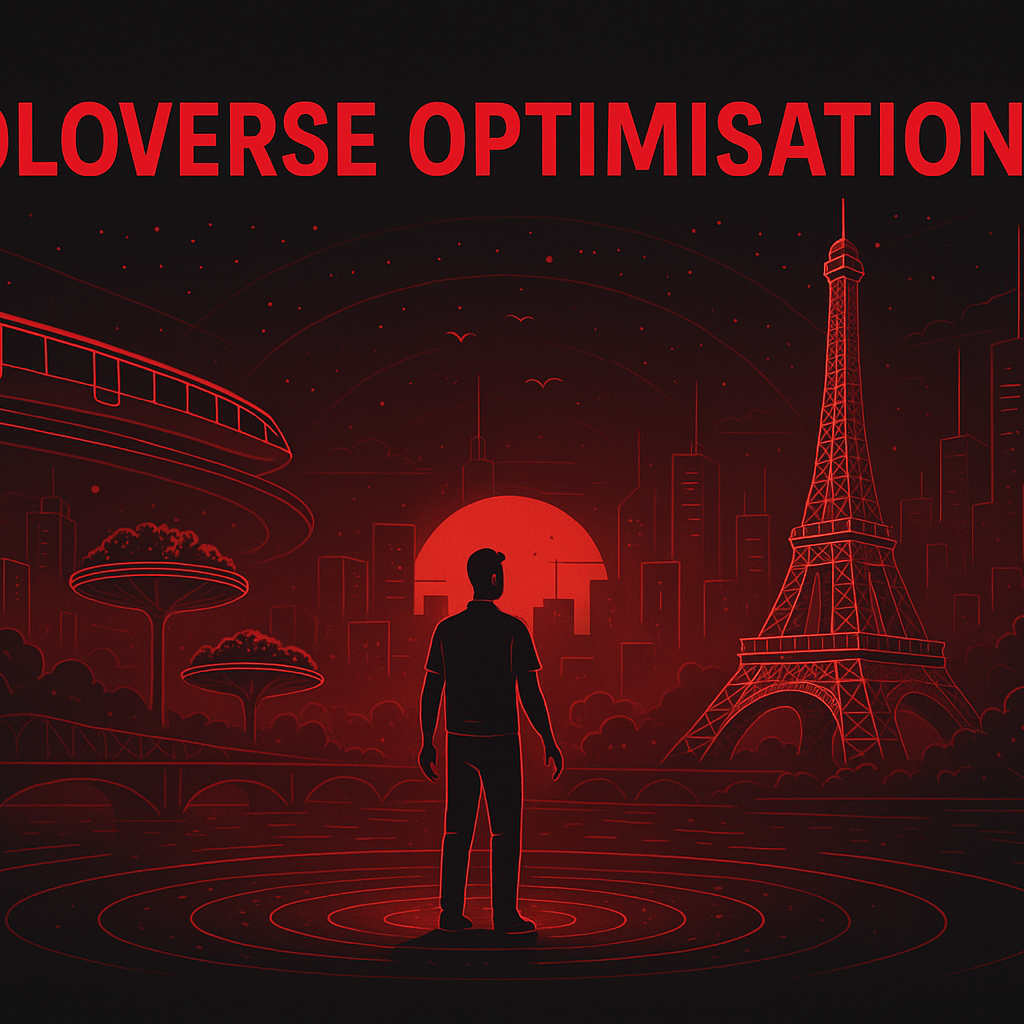
Hyperreality SEO
In the age of hyperreality, search ceases to be a mere retrieval of pages and becomes the architect of worlds. Enter Hyperreality SEO: the discipline born where virtual environments, AI-driven simulations and our physical surroundings converge. As queries evolve into immersive experiences, your optimization strategies must too.
Imagine a user whispers into their AR glasses: “Show me the quiet café in the floating city for a meeting with my avatar.” Behind that simple prompt lies a layered process: search-indexing of 3D spaces, metadata that describes ambience and availability, real-time rendering of virtual geometry and AI-agents serving the user in context. In this world your “landing page” is no longer a web page—it is a virtual plaza, a digital twin, a simulverse room where brand and user co-exist.
Why is Hyperreality SEO urgent? Because the market is expanding at spectacular speed: the global metaverse economy alone was estimated at US $105.4 billion in 2024 and is projected to hit US $936.6 billion by 2030. With so much traffic shifting toward immersive worlds, being visible in the physical web will no longer suffice. Traditional SEO was about keywords and links. Hyperreality SEO demands three-dimensional asset optimization, voice-and gesture-based queries, real-time spatial indexing and AI-driven contextualization.
Some core pillars of Hyperreality SEO:
- Virtual Asset Metadata: optimize 3D models, digital twins, avatars and environments with rich schema and semantic tagging so search-engines for immersive worlds can “see” you.
- Spatial Search & Discovery: design your virtual environment so it’s discoverable via voice (“nearest café”), via gaze (“highlighted space”), and via gesture (“pull menu from wall”).
- AI-Driven Narrativeloops: your virtual space must adapt dynamically—through chatbots, evolving environments, and user-driven branching paths—that keep users engaged post-search.
- Bridge-Reality Connectivity: Ensure your virtual presence links to your physical counterpart and vice versa—so that real-world queries can surface immersive worlds, and immersive worlds can lead to real-world conversions.
Here’s a hypothetical scenario: A boutique hotel builds a digital twin in a city-metaverse. A guest types “romantic rooftop suite view Kolkata sunset” into a spatial-search interface. Within a second, the hotel’s 3D twin appears, showing views, ambient music, and a virtual mini-tour. The guest then toggles “book real room” or “join virtual stay”. The result: the hotel has not just optimized for classic Google search, but also for spatial search + immersive experience. Suppose just 1 % of its bookings originate from that virtual channel, and its average room rate is ₹9,000/night. In that case, each 100 bookings via the virtual channel generate ₹9,00,000 in revenue—illustrating how optimizing for hyperreal search opens entirely new revenue streams.

Simulverse SEO
In the world of the Metaverse, Simulverse and Hyperreal Search, one might think SEO stands for “search engine optimisation” — but emerging from the corridors of immersive worlds is a new discipline: Simulverse SEO. Here, optimisation is not merely for ranking pages — it is for surfacing entire simulated realms, avatar-contexts and living digital architectures at the exact moment a user says “Show me”.
Imagine a hypothetical scenario: You enter a virtual plaza inside a Simulverse built by THATWARE, you ask “Find a 1920s-speakeasy experience with jazz and electric vehicles”. The Simulverse engine interprets your query, constructs the environment, positions you in a simulated world, and delivers it seamlessly. The optimisation challenge? Ensuring that your speakeasy world appears faster, loads seamlessly, and aligns with your context — not just as a link, but as an experience.
Core Elements of Simulverse SEO
- World-Indexing: Tagging and indexing 3D spaces, persistent simulations, and avatar events so they become discoverable within metaversal search systems.
- Query → Generation Mapping: Rather than matching keywords, mapping user intent to interactive world-constructs.
- Experience Performance: Load times, simulation fidelity, avatar physics — the “experience SEO” metrics replace classic page speed and links.
- Narrative Relevance: The quality of the generated world in relation to the user’s context becomes the key metric.
To anchor this in data: the metaverse ecosystem already counts over 600 million active users worldwide according to a recent summary of 2025 statistics. Meanwhile, traditional SEO still dominates web traffic: organic search accounts for reported 53% of online traffic in one study. Now if we assume that even a modest 10% of those 600 million users seek immersive experiences via simulverse search, that is 60 million potential queries each month — a new frontier for optimisation.
In our hypothetical numbers: 60 million queries × conservatively USD 0.10 value per successful session = USD 6 million monthly value in uncovering and delivering immersive worlds. Scaling over a year, that’s roughly USD 72 million for a single Simulverse channel. Increase the value-per-session to USD 0.50 and the annual becomes USD 360 million. These rough calculations illustrate the magnitude of opportunity.
As the architecture of metaversal search systems evolves — see research on “metaverse retrieval” frameworks that index complex 3D worlds rather than webs of links. For industries, the task is clear: create simulverses that are not only compelling to inhabit but optimised to be found. The parallel to classic SEO is useful, but the stakes are higher: you are optimising worlds, not web pages.
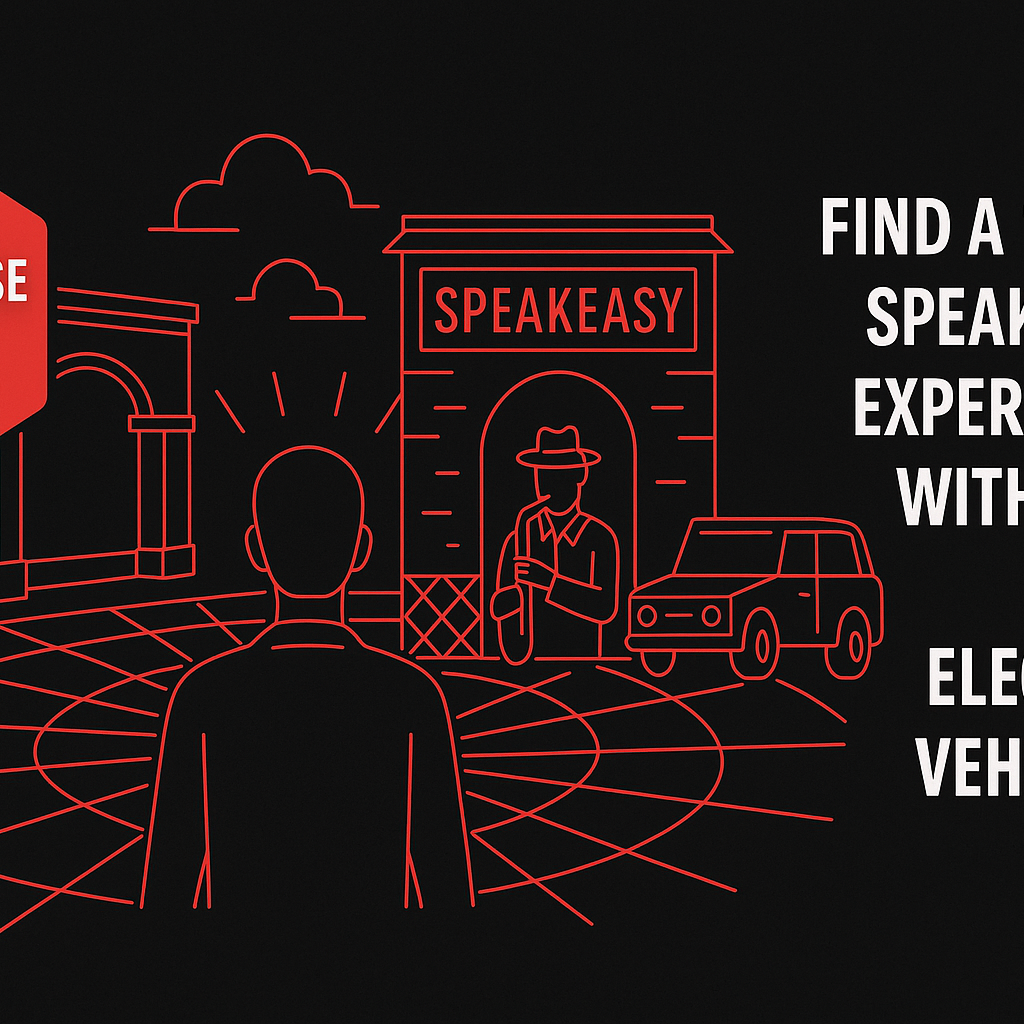
Meta-Continuum SEO
As we enter the emergent era of “search as world-making,” the notion of Meta-Continuum SEO takes centre stage. Imagine this: you issue a query and instead of simply retrieving a list of links, you trigger a self-evolving simulation — a dynamic, layered “continuum” of realities, where virtual, augmented and physical terrains merge. This is not merely optimisation of content, but optimisation of contexts, systems, and entire worlds.
Consider a hypothetical situation: A user types “eco-tourism experiences Amazon basin” into THATWARE’s metaversal search engine. Instantly, the system spawns a virtual-physical hybrid space: a 3-D rainforest simulation layered over real-world satellite data, populated with AI agents representing local guides, dynamically generating itineraries, immersive audio-visual feeds, links to bookings, social hubs and peer-reviews. The query didn’t just find information — it created an experience, populated with actionable pathways and personalised sub-worlds. That is Meta-Continuum SEO in action.
In this paradigm, optimisation targets shift:
- Keywords → Contextual Nodes: queries become anchors in a network of nodes (virtual places, avatars, services, experiences) rather than simple phrases.
- Links → Bridges: internal and external links morph into dynamic “bridges” between simulated realms, meta-realities and the user’s personal journey.
- Content → Continuum: instead of standalone pages, content becomes persistent zones within a fluid continuum that evolve with user interaction.
- Searcher → Co-Creator: the user is no longer a passive consumer but an active inhabitant and modulator of the world generated by their query.
To appreciate the scale: the global metaverse market was valued at USD 105.40 billion in 2024 and is projected to reach USD 936.57 billion by 2030, growing at a compound annual growth rate (CAGR) of ~46.4% between 2025–2030. Suppose we treat Meta-Continuum SEO as capturing just 1% of that growth in realised virtual-search-experience value by 2030. In that case, that suggests around USD 9.4 billion of value focused purely on search-engine-driven virtual worlds.
And with user numbers also mounting (over 600 million active users in metaverse-type environments in 2025) the opportunity is not only financial but experiential: Search becomes the scaffold of entire universes.
But there are risks and questions, too: what happens when optimisation strategies aim to generate entire worlds rather than web pages? How do we ensure these worlds are interoperable, inclusive and not just echo chambers of algorithmically curated realities?
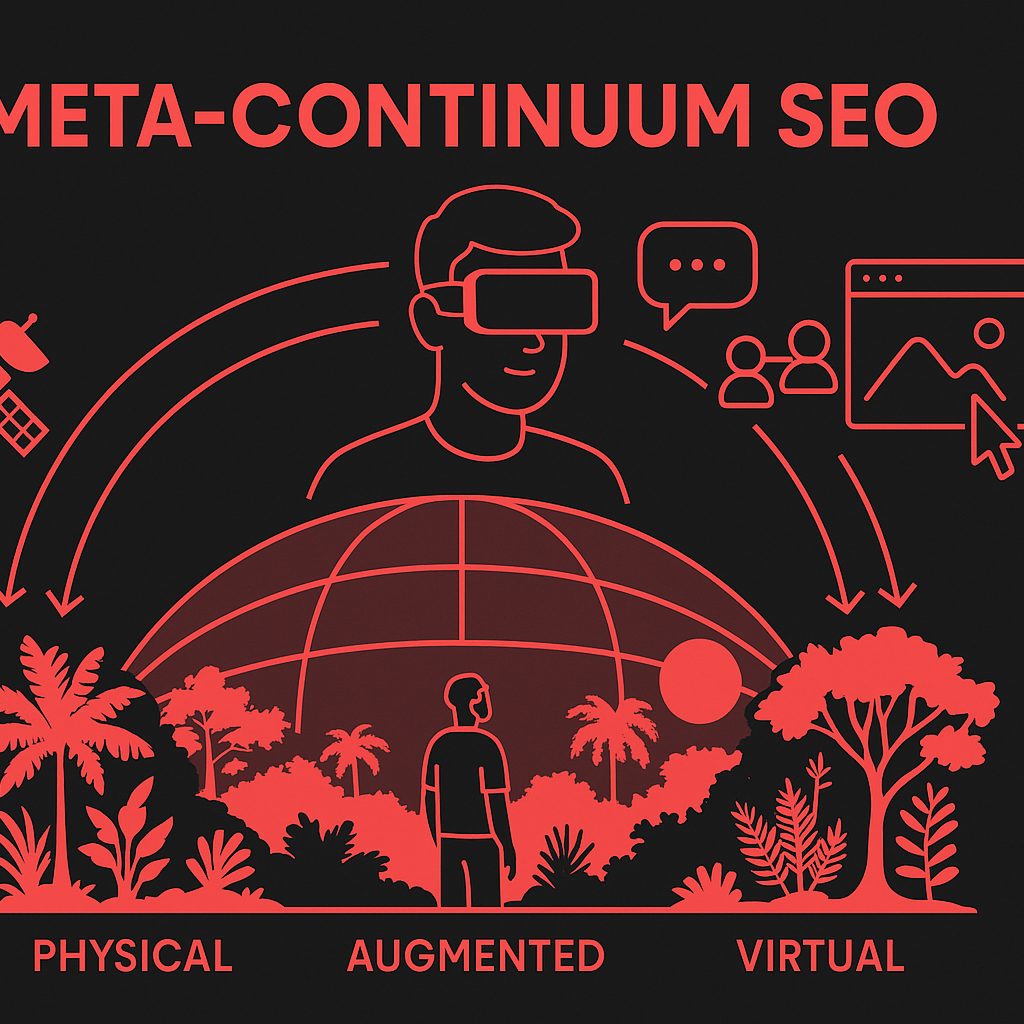
Recursive SEO
As we stand on the threshold of search’s next grand evolution, the term Recursive SEO emerges—not simply as an optimisation tactic, but as a self-amplifying loop within the realm of digital presence. In the world of the metaverse, simulverse and hyperreal search, Recursive SEO becomes the method by which each query, each link, each simulation, feeds back into the system and generates new search-paths, new virtual contexts and new realities.
Imagine a brand-avatar in the simulverse of THATWARE. A user types “carbon-neutral smart home” into their metaversal engine, and the result isn’t a single page—it’s a persistent micro-world: virtual house models, user-customised dashboards, interactive simulations of energy flows. Now, thanks to recursive optimisation, every avatar who visits that micro-world leaves an interaction-trail, which triggers a fresh indexing wave, spawning variant universes (eco-village, desert-dwelling, floating-city), each tailored to a different search subset. That brand’s content doesn’t just climb rankings—it multiplies universes.
In practice, Recursive SEO leverages three core mechanics:
- Iteration: Every new search outcome becomes a seed for new content or environment. One query → one virtual world → many spin-offs.
- Feedback loops: User interaction signals feed optimisation engines, which then redirect the query-engine to spawn adjacent simulations, reinforcing ranking and visibility.
- Network-effect compounding: Each simulverse iteration links to other iterations, creating a richly inter-connected mesh; the higher the network density, the stronger the ranking gravity.
Consider some numbers to anchor this in reality: organic search still delivers roughly 53% of website traffic, compared to only 5% from social media. In a scenario where a Recursive SEO system spawns five variant worlds from one core query, and each variant attracts just 10% more user-interaction than the original, the compounding effect across five iterations will yield 1×1.105≈1.611 × 1.10^5 ≈ 1.611×1.105≈1.61 — i.e., a 61% amplification in visibility from one seed query. Similarly, given that more than 58% of U.S. Google searches are “zero-click” (users get answers without clicking through) a Recursive SEO model aims to convert those zero-click moments into immersive simulverse experiences that hold the user inside the query-world rather than send them off to other domains.
In sum: Recursive SEO reframes optimisation from a linear “content → link → rank” model, into a cyclical world-building cycle: query triggers world, world generates more queries, queries spawn more worlds. The goal is not only to appear on the first page of results but to become the universe where the query lives. In this chapter, we will unpack how Recursive SEO works in the metaverse era, the technical architecture of loop-driven indexing, and the implications for brands, creators, and search ecosystems alike.

Reality Shard SEO
In the age of hyper-connected realities, “Reality Shard SEO” emerges as the next frontier in digital discovery: it is the art of optimising for fragments of reality—shards of virtual, augmented, and hybrid worlds—that increasingly stand beside, or even replace, traditional web pages. As we journey into this terrain, imagine a scenario: you query “ocean expedition in Mars habitat”. In seconds, the query spawns a self-contained simulverse: a VR module, a time-lapse of terraforming tech, live chat with a virtual researcher, AR overlays, and even a commerce gateway for an expedition-kit. That is Reality Shard SEO in action.
What defines a “reality shard”?
- A micro-universe or persistent interactive environment triggered by search: think of a 3D room or AR layer tied to a query rather than a static page.
- It is optimised for discovery, relevance and immersion: metadata, AI-agent engagement, spatial layout and user journey all matter.
- It spans the spectrum: from AR overlays on real streets to full VR worlds, simulations and “dreamscapes” built on data.
- The user doesn’t just find information—they enter, explore, manipulate, and contribute to the shard.
Key implications for SEO and digital strategy
- Ranking becomes about world-construction: how quickly and compellingly a shard spins up, how it retains dwell time, how it fosters interaction.
- Metrics shift: average session length, avatar engagements, shared heritage among users, user-generated content inside the shard.
- Thinking “keywords” evolves into designing intent-spawned modules: you design not just for crawl but for creation-trigger.
- Legacy content becomes layers: an article may serve as anchor, but the shard is the immersive extension.
Hypothetical calculation
Suppose a brand launches a reality shard for “Mars diving tour”. If the global metaverse market is estimated at USD 105.4 billion in 2024 and projected to reach USD 936.6 billion by 2030 (CAGR ≈ 46.4 %), then the brand captures 0.001% of the 2024 value → ~USD 1.054 million. If the user-session value (ads + commerce) per shard session is USD 5, then it needs ~210,800 sessions to break even. As engagement rises, a 50% increases in dwell time may double conversion.
This shows: making a reality shard is akin to building a micro economy inside search.
Why now?
- There are already over 600 million active users in metaverse-type environments.
- Technologies that power shards—XR, edge compute, AI agents, digital twins—are maturing rapidly.
- The search paradigm itself is loosening: a user isn’t satisfied with a link; they seek an experience.
- Brands and platforms will compete to own shard real-estate when every query has the potential to spawn a universe.
Reality Shard SEO is more than a buzz term—it’s the vantage point where search evolves into creation. In that instant, you launch a shard, you invite worlds to emerge around your query. The query becomes a genesis point. In the next chapter, we’ll unpack how shards are architected, measure,d and monetised—and what governance and ethics emerge when we optimise not just for clicks, but for existences.
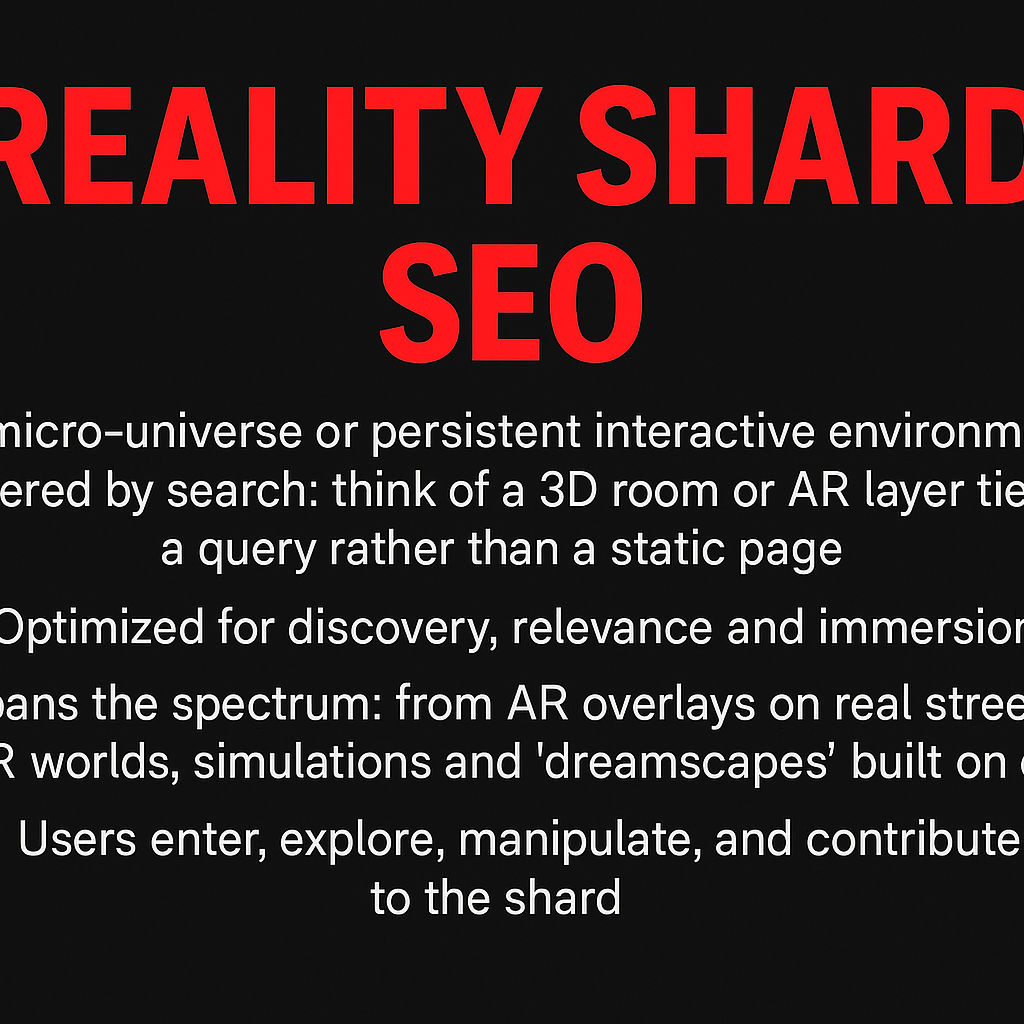
Reality Fracture SEO
In the emerging landscape of what we might call “Reality-Fracture SEO”, the act of search fractures one stable reality into many. The query no longer simply retrieves content—it shatters a singular virtual mirror and spawns alternative simulations. Imagine this: you input “urban garden ideas”, and rather than getting a list of articles, you’re plunged into a 3-D simulverse where your garden grows, evolves, multiplies, and invites interaction. In this paradigm, the query becomes inception, the result becomes realm.
What Reality-Fracture SEO means
- Search engines evolve into world-builders rather than indexers: your keyword triggers a branching virtual world where each branch is a variant of reality.
- These variants are tailored, personal, adaptive: perhaps one version emphasises climate resilience, another aesthetic design, a third budgeting—each one a mini-universe spawned by one search.
- In that fracturing, SEO transforms from “optimise for visibility” to “optimise for immersion & branching possibilities”. A single search spawns maybe n versions of a reality, where n grows with personalisation and real-time data.
- For example, if a digital engine spawns 5 tailored simulations per keyword, and your platform serves 1 million queries/day, that’s 5 million worlds created daily.
Hypothetical scenario
Consider the platform of THATWARE: A user queries “medieval marketplace design”. The system immediately generates—
- A high-fidelity VR simulation of a 14th-century town square where users can walk and trade;
- A mixed reality overlay for AR devices showing how one might build such a market in real space;
- A budget-friendly 2-D browser simulation for global users with lesser hardware;
- A narrative-driven variant where you role-play as a merchant making decisions;
- A data-analysis simulation that shows consumer behaviour, mapping what items sell and when.
Each branch is an answer, but also a world—fracturing what used to be one result into many living spaces.
Why this matters
Globally, the metaverse market is projected to grow from about USD 105.4 billion in 2024 to USD 936.57 billion by 2030, at a CAGR of approximately 46.4%. And in the world of traditional search, about 68 % of online experiences begin with a search engine. Together, these figures suggest a convergence: search meets immersive worlds. If 68 % of experiences begin with search, and the immersive-world economy is nearly a trillion-dollar frontier, then “search spawning worlds” becomes a commercially immense and conceptually transformative arena.
Implications for optimisation
- Keywords become entry-points rather than endpoints. The metric shifts from click-through-rate to world-engagement-time.
- Metadata, schema, semantic-graph structuring must encode branching logic: which simulation variant is relevant, what triggers which world.
- Performance optimisation now includes UI/UX across VR/AR/web, latency of world generation, runtime adaptivity.
- Analytics evolve: track not just “which result” but “which branch of reality”, dwell-time in each world, bounce-rate between worlds.
In essence, Reality-Fracture SEO envisions a future where search is creation, where each query fractures a single reality into many, and the optimiser’s job is to ensure that your world is the one you live in.

Meta-Continuum SEO
In the ever-expanding vista of digital experience, the concept of Meta-continuum SEO emerges as a frontier strategy: where optimisation transcends the search bar and enters layered virtual realms. In this chapter we explore how the traditional anatomy of SEO — keywords, backlinks, metadata — metamorphoses into the orchestration of spatial, immersive, and algorithmically-driven environments, optimizing not just content but entire worlds.
Imagine a hypothetical situation: a luxury fashion brand enters a virtual shopping district in the Metaverse. Instead of optimizing pages for “best leather boots”, the brand now optimises a three-dimensional virtual boutique for discovery: spatial placement of items, accessibility of interactive avatars, voice/gesture search prompts and metadata for digital goods. That boutique becomes a node in the meta-continuum of search — where every query spawns a universe of brand, experience and commerce.
Traditional metrics like click-through-rate and bounce-rate begin to take on new meaning; dwell time becomes “time within the virtual node”, interaction becomes “immersive conversions”.
Key bullet-points of Meta-continuum SEO include:
- Optimising virtual asset metadata (3D models, digital twins, NFTs) for discoverability in metaversal search engines.
- Optimising for voice, gesture, and avatar-based queries rather than typed keywords.
- Designing persistent virtual spaces that evolve, adapt and interconnect (inter-virtual backlinks) to build authority.
- Analysing metrics of spatial engagement, avatar movement, virtual-property interactions—rather than just pageviews.
From a strategic perspective, the opportunity is monumental. The global metaverse market is projected to grow from roughly USD 105.4 billion in 2024 to about USD 936.6 billion by 2030, representing a compound annual growth rate (CAGR) of ~46.4%. That means: if a brand today invests “X” in meta-continuum optimisation and gains even a 1% share of that growth cycle, the payoff in virtual-asset visibility could dwarf traditional web-search ROI. For example: if market is USD 105 billion and grows to 936 billion, that’s ~+830 billion increase. If an SEO investment captures 1% of new virtual real-estate value, that’s ~$8.3 billion in potential. (Purely illustrative.)
The shift from “Find → Click” to “Enter → Interact” is driven by AI, spatial computing and immersive tech. According to research on how the Metaverse will shape SEO strategies, businesses must now account for VR/AR search behaviour alongside text-based queries. In this meta-continuum model, when a user “searches” they don’t merely get results: they enter a simulation built around their query. The query triggers a world.
This evolution demands that marketers, architects and technologists collaborate: SEO becomes world-building. And within the meta-continuum, search equals creation. The brand that masters meta-continuum optimisation doesn’t just show up in search—they host the experience that search brings into being.

Hyperversal SEO
In the age of the hyperreal, SEO is no longer simply about keywords and rankings. Enter Hyperversal SEO: a discipline in which the engine doesn’t just reflect a real-world site—it spawns a universe. As digital and physical realms merge, the query becomes a portal, the click becomes an act of creation.
Consider a hypothetical situation: you type “Italian street-food experience in virtual Kobe” into a metaverse-search interface provided by THATWARE. Instead of a list of links, the system launches a simulverse: a neon-lit street in downtown Kobe — which you enter via your avatar, smell the sizzling yakitori, chat with local vendors, watch VR actors prepare takoyaki, and then are offered to book a hybrid real-+-virtual experience. Your “search result” is not a page, but a world you inhabit.
What does Hyperversal SEO entail in this realm?
- Universe-Indexing: Instead of indexing web pages, the engine maps persistent virtual domains, layered AR spaces, avatar-agents and simulation modules.
- Query-to-Construct: A search triggers generative AI that assembles or adapts a world in real-time, guided by intent, context, avatar history, device capabilities.
- Spatial-Relevance: Instead of SERP relevance, ranking depends on how well the simulation aligns with the user’s context: physical location, VR/AR device, previous world-interactions.
- Economy & Ownership Signals: In the simulverse economy, virtual assets, avatars, and user-generated worlds carry value. SEO must optimise for simulation-ownership signals (who built the world, how often visited, how many transactions).
- Interaction-Metrics over Clicks: Engagement isn’t measured in clicks but in dwell-time, world re-entry, cross-avatar interactions.
Let’s do a simple calculation for scale: The global metaverse market is estimated at USD ≈ 105 billion in 2024. If Hyperversal SEO tools capture even 1% of this market revenue, that’s USD ≈ 1.05 billion. Now project a CAGR of ~46% from 2025-2030. If we assume Hyperversal-capable engines capture 5% of the market in 2030, the addressable revenue jumps dramatically. The math: starting at 105 B, growing at 46% for 6 years → ~105×(1.46)^6 ≈ 105×(≈7.2) ≈ USD 756 billion. At 5% capture, that’s ~USD 37.8 billion. A sizeable incentive.
These numbers underline that Hyperversal SEO is not a niche experiment—it is strategic. From simulations built for commerce, education, social gatherings, to brand presence and virtual asset ecosystems, all must be optimised for world discovery, not just page discovery.

Metaverse of Metaverses SEO
In a world becoming ever more layered, where digital and physical realms don’t just overlap but fuse, the idea of a metaverse of metaverses emerges as our next frontier. Imagine a search engine not confined to the web, but one that activates portals into entire worlds—each query a seed, each result a universe. This is the domain of what we might call Metaverse-SEO, an approach where optimisation doesn’t just direct you to a page, but invites you into a fully realised virtual space.
Hypothetical scenario:
You launch a query—“eco-tourism in 2140”. Instead of simply retrieving text articles, the system spawns a mini-simulverse: an interactive island in 2140, complete with AI-tour guides, climate-adaptive hotels made of living coral, and regenerative agriculture farms. You walk, you explore, you interact. Behind the scenes, the SEO engine has activated spatial content, avatar agents, narrative nodes, data streams, and commerce opportunities. That query becomes a world.
What makes Metaverse-SEO distinct?
- Persistence: the moment you enter that world it remains open for others to join; the search result lives on as a place, not just a link.
- Interoperability: each mini-universe links seamlessly to others—so your “eco-tourism island” might connect via a portal to a “futurist architecture city” or “undersea research lab” universe. This network of virtual worlds becomes the “metaverse of metaverses”.
- Data → Experience: traditional SEO pushes keyword-rich pages; here, SEO optimises entire environments—terrain, avatars, economy, narrative arcs.
- Creation rather than retrieval: you no longer find information, you inhabit it.
Why does this matter? The global metaverse market alone is estimated at around USD 105 billion in 2024, and projected to grow to ~USD 937 billion by 2030 at a CAGR of ~46.4%. That scale hints at infrastructure, platforms and content ecosystems capable of sustaining this “search-as-world-creation” paradigm. If we take USD 105 billion in 2024 and apply that 46.4 % growth for 6 years:
105×(1+0.464)6≈105×(1.464)6≈105×(≈(1.464)6= (1.4643)2≈(3.14)2≈9.86)≈USD1,036 billion
which aligns closely with the USD 937 billion projection.
In this emerging terrain, SEO practitioners must rethink metrics: instead of click-through-rate or bounce-rate, we might measure “time-spent‐inhabiting”, “cross-portal transitions”, “avatar-engagement depth”, “economy generated inside the result world”.
Bullet points to consider:
- Keywords become world-tags: they seed an environment rather than a page.
- Algorithms curate not just relevance, but immersive coherence: spatial logic, avatar behaviour, narrative arcs.
- Search indexing includes spatial & temporal data: geometry of world, time-of-day simulation, multi-user synchronicity.
- Link equity morphs into portal equity: a portal from one universe to another boosts visibility and avatars’ traffic.
- Monetisation entwines with immersion: virtual real estate, brand worlds, experiential ads woven into the simulverse.
To frame it in one sentence: Metaverse-SEO transforms each query into a creation event — when you search, you don’t just retrieve: you generate a world.

Pre-Reality Fields SEO
As the digital and physical realms fuse into hybrid landscapes, a new frontier emerges: Pre-Reality Fields SEO. Imagine a moment when you type a term, and instead of a list of links you enter a space—an engineered field where your query becomes environment, interaction, and persistent scenario. This is not mere optimization of web pages; it’s optimization of worlds.
What does this entail?
- Search that triggers environment creation rather than a static result.
- Data mapped into 3-D fields, immersive rooms, and ambient interfaces.
- Keywords evolving into spatial anchors and intent shapes becoming world blueprints.
- The user morphing from visitor into participant-shaper, navigating a simulverse tailored by AI and past behaviours.
Hypothetical light-scenario: A branded car company launches its new EV. A user searches for “eco luxury urban mobility 2030” and is transported into a virtual boulevard—a “pre-reality field” — where avatars drive through a future cityscape, hear testimonials, and experience interior features in first person. The search engine of the future doesn’t return pages — it spawns environments. Within this field, the brand narrative, user intent, and AI-generated context converge.
In this paradigm, the stakes are high. Consider the market forces: the global metaverse is estimated at ~$105 billion in 2024 and projected to reach ~$936 billion by 2030 (CAGR ~46%). Simultaneously, traditional search remains a dominant channel: 68% of online experiences begin with a search engine. Therefore, when search evolves into world-making, the opportunity is vast.
A little calculation:
If a brand currently spends $100K per year on SEO within traditional web search, and we assume a modest conversion uplift of 20 % by migrating into pre-reality field experiences (due to deeper engagement and immersive effects), that would equate to $120K value. But if the brand captures just 1 % of the projected metaverse marketing pie by 2030 in a $936 billion market (~$9.36 billion), their share would be $93.6 million—orders of magnitude beyond conventional SEO ROI.
Key dimensions of Pre-Reality Fields SEO:
- From keywords → experience vectors rather than strings.
- From SERPs → spatial environments rather than ranked lists.
- From pages → persistence fields, where content evolves and adapts.
- From users → co-creators, able to move, interact, and branch the world.
Brands and platforms that understand and implement this shift will be pioneering not just visibility but presence — becoming not only found, but inhabited.
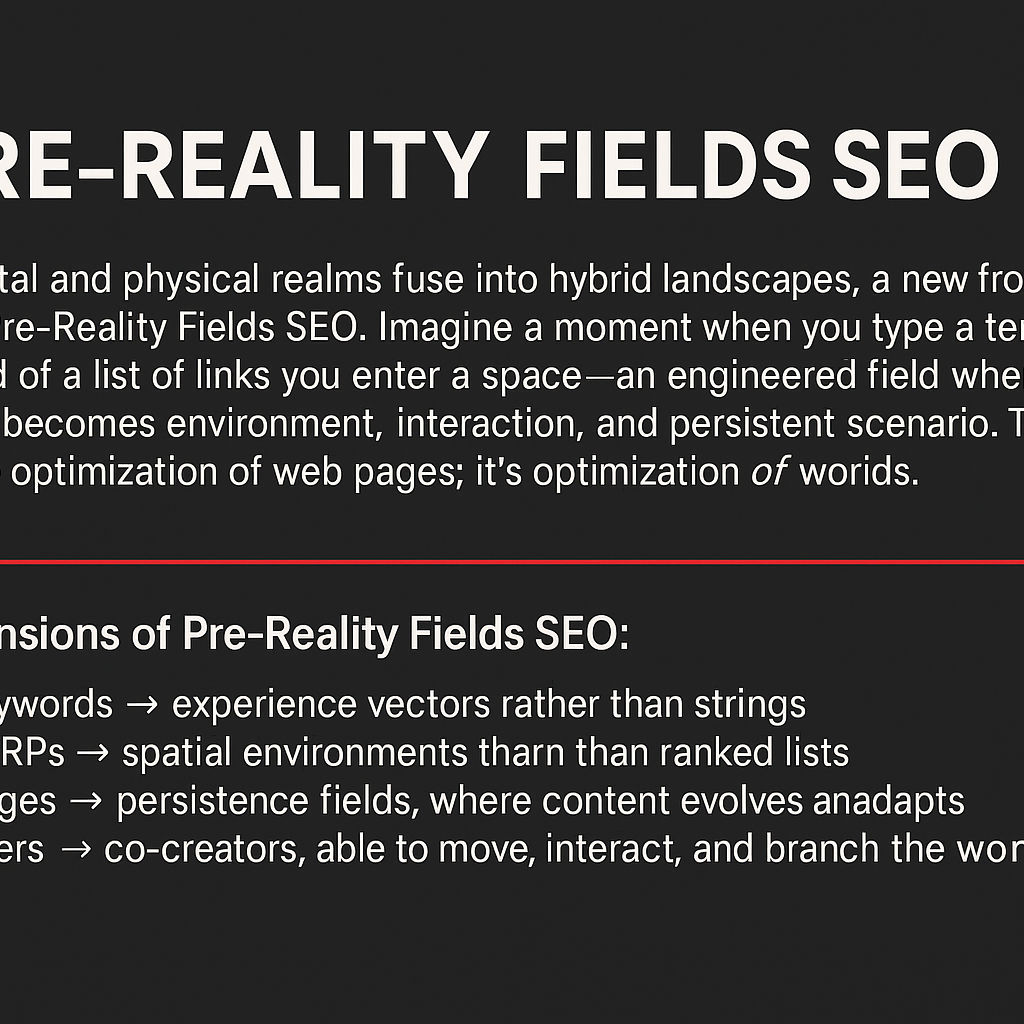
Potentiality SEO
In a universe where search is no longer just about finding what is but about conjuring what could be, we arrive at the idea of Potentiality SEO — an evolution of optimisation that reaches beyond retrieval and into creation. When the digital and physical fuse, and query meets possibility, every search becomes the seed of a world.
Imagine this hypothetical scenario: you type a query into a platform by THATWARE — “design me a community for remote artists in the metaverse” — and instead of a list of links, you receive a living sandbox: a virtual site, populated by avatars, templates, simulated economics, collaborative tools, and analytics. You are no longer just searching; you are incubating a space, a “simul-place,” built on the fly, adapted in real time. That is Potentiality SEO: optimisation not for ranking, but for reality-generation.
Some key pillars of Potentiality SEO:
- Search → Potential: Rather than helping someone find an answer, the query triggers a dynamic world state.
- Optimisation → Enablement: Instead of optimising for clicks and traffic, we optimise for generative signals, adaptive contexts and user-co-creation.
- Content → Composable Systems: The “content” returned is not static pages but modular experiences — data, narrative, space, agent behaviour.
- User → World-Builder: The searcher becomes a creator, inhabitant and editor of the reality birthed by their query.
Why this matters: Conventional SEO statistics still emphasise the power of organic search. For instance, organic search accounted for roughly 53 % of all trackable website traffic in recent studies. And with the global virtual-world market — the landscape into which Potentiality SEO feeds — projected to grow from about USD 105 billion in 2024 to nearly USD 937 billion by 2030 (a CAGR of 46.4%) we see a vast arena opening for optimisation of newly emergent spaces.
Let’s run a brief calculation to illustrate scale. If a brand currently earns USD 1 million per year via conventional organic search traffic, and the metaverse‐space grows approximately 8–10× by 2030, then the potential incremental value of having a presence built via Potentiality SEO could be on the order of USD 8–10 million, assuming similar conversion and engagement rates. The multiplier may be far greater if new behaviour patterns and immersive economies evolve.
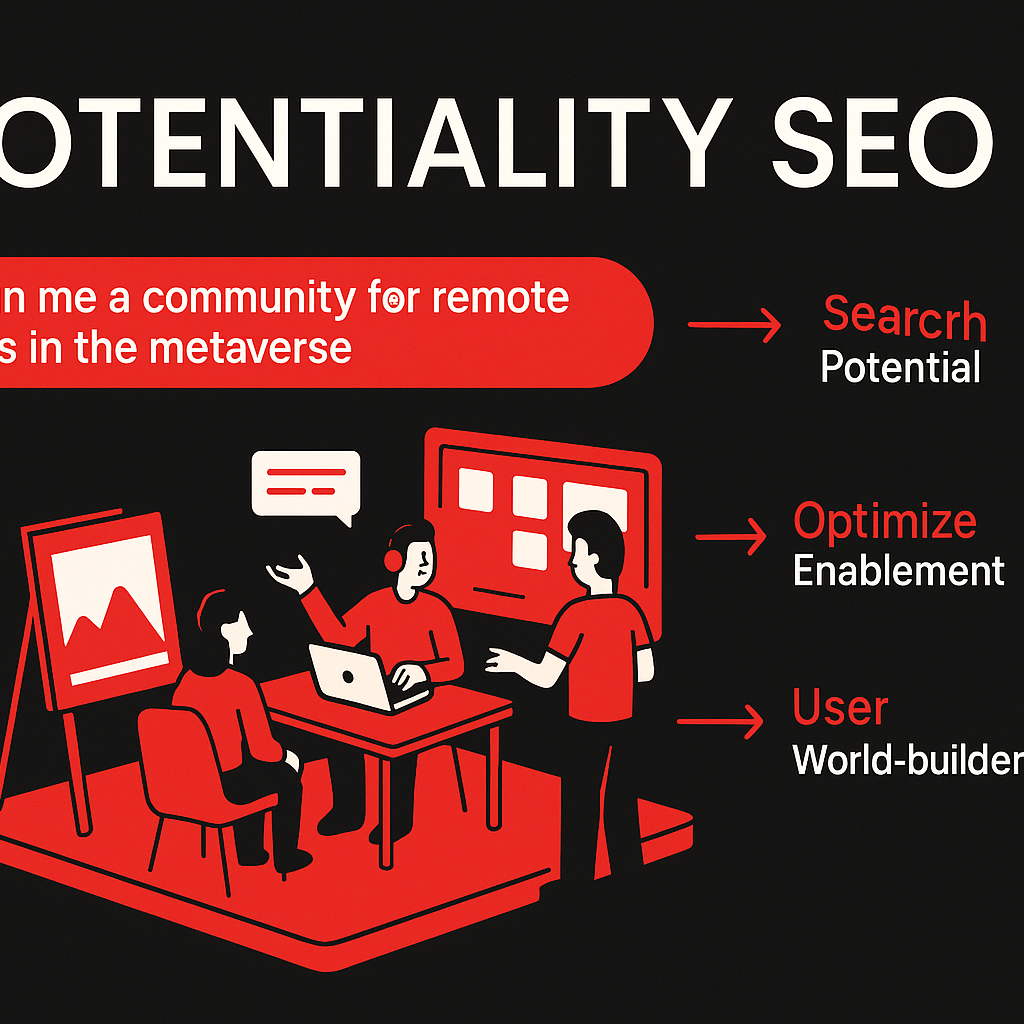
Cross-Engine Multiverse SEO
In the emerging construct of “Cross-Engine Multiverse SEO,” the age-old quest for top-rankings evolves into a dynamic orchestration of visibility across multiple reality engines—from classic web search to immersive metaversal spaces and simulated universes driven by AI. Here’s how to understand this paradigm.
What is Cross-Engine Multiverse SEO?
Imagine a hypothetical scenario: your brand launches a virtual storefront in a metaverse platform. A user enters the query “stylish sustainable sneakers,” and rather than returning a flat list of links, the search spans across:
- a traditional web search engine result page,
- a spatial, 3D “store-world” inside a metaverse engine,
- an AI-agent-driven simulverse where the user can view, pick up, and customise sneakers before checkout.
In effect, one search query spawns a universe of experiences—each “engine” (web, metaverse, simulation) plays a role. Cross-Engine Multiverse SEO is the art and science of optimising for all these engines in tandem, ensuring visibility, engagement and conversion across layered realities.
Key Considerations & Strategic Dimensions
- Engine Diversification: Traditional SEO still matters—organic search delivers roughly 53% of trackable website traffic. But if you ignore metaverse venues, consider that the global metaverse market is projected to reach ~ US$936.6 billion by 2030.
- Semantic & Spatial Optimisation: It’s no longer about keywords alone, but about world-contexts. Queries must map into virtual scenes, avatar interactions and immersive content layers.
- Measurement & ROI Calculation: If your metaverse presence sees 100,000 sessions and a 2% conversion rate, that’s 2,000 transactions. If each transaction is worth US $50, the revenue is US $100,000. Compare that to your web channel: say 500,000 visits at 1% conversion = 5,000 transactions × US $40 = US$200,000. This data-driven comparison informs whether virtual-engine investment pays off.
- Adaptive Content & Backlinks beyond Web: In multiverse SEO, “links” might mean portal-referrals, avatar-invitations, meta-objects referencing your brand. Traditional backlinks still matter—pages ranking in Google’s top 10 often are three years or older.
- Zero-Click & Immersive Discovery: With over 58% of U.S. Google searches generating no click, thanks to instant answers and AI summaries. In a simulated scenario, the user may never see a traditional SERP: they’re immersed directly in a branded world.
Use-Case
A fashion brand uses Cross-Engine Multiverse SEO by:
- Optimising blog content (web engine) for “virtual try-on sneakers”.
- Deploying a mini-world in a metaverse engine where avatars try and share the sneakers.
- Offering an AI-driven simulation where the user visualises how the sneakers perform in augmented-reality daily life.
By coordinating all three, the brand captures attention across search, immersion, and simulation. The query triggers a multi-engine journey: from web click → virtual walk-through → purchase decision in simulation.
Why This Matters
As digital and physical realms merge, the boundaries between “search” and “experience” blur. A query now doesn’t just retrieve—it generates. When you optimise across multiple engines—web, metaverse, simulverse—you’re future-proofing for a time when every search spawns a universe.

Conclusion: THATWARE — The Architect of Simulated Existence
Every search becomes a creation code.
As we step beyond the boundaries of the traditional web into realms where reality, simulation, and imagination converge, THATWARE emerges not merely as a company—but as an architect of simulated existence. What began as the optimisation of web visibility has evolved into the orchestration of multiversal presence. Here, search is no longer a tool of discovery; it is a language of creation. Every query becomes a creation code, generating new worlds, relationships, and narratives within a vast and intelligent network of realities.
In this transformed landscape, Cross-Engine Multiverse SEO stands as the connective tissue of all digital realities. It ensures that no matter where a user searches—on a traditional browser, in a metaverse hub, or within an AI-driven simulverse—the essence of an idea, brand, or identity remains visible, contextual, and alive. Visibility is no longer measured in rankings alone; it is measured in presence across worlds.
THATWARE’s vision reframes “search” as a multidimensional act of creation:
- Each algorithmic interaction becomes a seed that spawns an ecosystem of simulated experiences.
- Each digital footprint evolves into a living construct, adapting, interacting, and learning within the hyperreal fabric.
- Each optimisation parameter shapes the physics, aesthetics, and semantics of a digital world.
This is not simply the next phase of SEO; it is the dawn of Existential Engineering—the science of building realities from queries. As the global metaverse economy surges toward nearly $1 trillion by 2030, the interplay of AI and immersive search will define how societies experience information, commerce, and connection. In this paradigm, THATWARE becomes the master builder, designing the algorithms that breathe life into virtual domains, ensuring coherence, discoverability, and creative integrity across infinite engines.
The implications are profound. When every search spawns a universe, knowledge ceases to be static—it becomes experiential. Searchers become world-builders, brands become ecosystems, and SEO becomes world design. THATWARE’s role, then, is not just to optimise for visibility, but to script the DNA of emerging realities—to write the code by which future civilizations will navigate their hyperreal existence.
In the end, we realise:
Search is creation. Data matters. AI is the architect. And THATWARE is the bridge between thought and world.
In this grand fusion of minds, machines, and multiverses, every keystroke is no longer a request for answers—it is the genesis of new existence.

